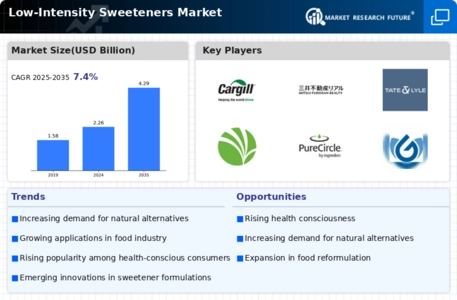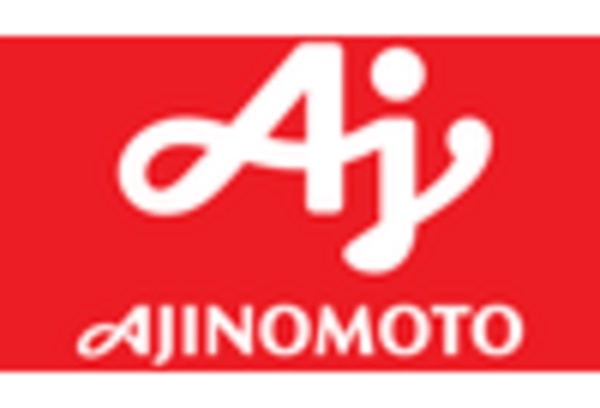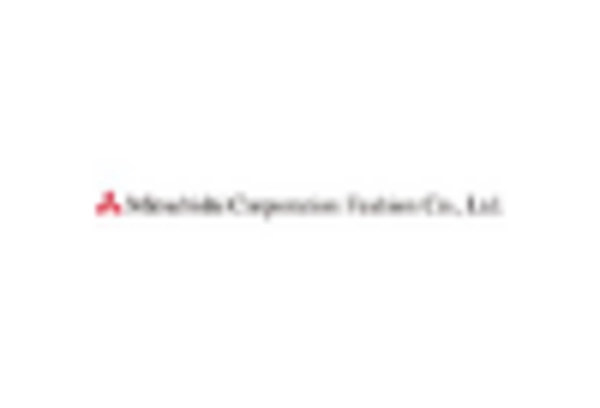Market Analysis
Low-Intensity Sweeteners Market (Global, 2024)
Introduction
The low-intensity sweeteners market is experiencing a major transformation, as the trend of dietary preferences moves towards healthier and more sustainable food choices. Sugar, which is linked to obesity and diabetes, is being increasingly associated with adverse health effects, which is driving the demand for sweeteners that offer sweetness without the associated calories. This market offers a wide range of products, including both natural and artificial sweeteners, which can be used in various applications in the food and beverage, pharmaceutical, and personal care industries. As manufacturers seek to meet the evolving needs of health-conscious consumers, the low-intensity sweeteners market is becoming increasingly competitive, with a focus on improving the taste of products while maintaining their integrity. In addition, regulatory developments and advances in extraction and production technology are reshaping the market dynamics, presenting both challenges and opportunities for market participants. Understanding these trends is critical for companies looking to capitalize on the growing demand for low-calorie sweeteners.
PESTLE Analysis
- Political
- In 2024, the regulation of low-sugar sweeteners is heavily influenced by government health policies. The European Union has stricter regulations on food additives, including sweeteners, and the European Food Safety Authority (EFSA) has reviewed over 50 different sweeteners in the last year alone. Similarly, the U.S. Food and Drug Administration has proposed new labeling requirements that would force the manufacturers of over 20,000 food products to reveal more information about their use of low-sugar sweeteners.
- Economic
- The economic environment for low-intensity sweeteners is influenced by the fluctuations of commodity prices and the behavior of consumers. In 2024, sugar prices have risen to 25 cents per pound, which has forced food manufacturers to seek low-cost substitutes like low-intensity sweeteners. Furthermore, consumer spending on health and well-being products has risen by 12 percent annually, with an estimated 150 billion dollars spent on health-related foods, thus indicating an increasing demand for low-calorie sweeteners.
- Social
- In 2024, social trends point to a change towards a healthier diet, with more than sixty-five per cent of consumers actively looking for products with reduced sugar content. In particular, millennials and Generation Z are more likely to prefer low-intensity sweeteners to sugar. A survey showed that forty per cent of consumers were concerned about the health risks of sugar, and were therefore looking for sweet alternatives without calories.
- Technological
- The technological developments in the field of food science play a major role in the development of low intensity sweeteners. In 2024, more than thirty new varieties of low intensity sweeteners have been introduced. These are based on fermentation and extraction processes that increase the flavour while preserving the low caloric content. Also, the analytical technology for the testing of the sweeteners has been further developed, and there are more than 100 new studies in peer-reviewed journals.
- Legal
- The legal framework regulating the use of low-intensity sweeteners is evolving. New laws have been proposed to ensure the safety of consumers and the transparency of labeling. In the United States, the Food Labeling Modernization Act of 2024 requires clearer labeling of artificial sweeteners on the packaging, affecting about 15,000 manufacturers. The European Union has also revised its regulations and has imposed stricter limits on the daily recommended intake of certain sweeteners, which has affected the formulation of products throughout the continent.
- Environmental
- Environmental concerns are increasingly influencing the market for low-intensity sweeteners, especially in terms of their production and sourcing. By 2024, it is estimated that around a quarter of low-intensity sweeteners will come from sustainable sources, with companies also pledging to reduce their carbon footprint. In addition, there is pressure to adopt eco-friendly packaging solutions, with 30 % of consumers willing to pay a premium for products that use biodegradable materials.
Porter's Five Forces
- Threat of New Entrants
- The barriers to entry in the low-intensity sweeteners market are moderate because of the need for substantial investment in research and development, regulatory approvals, and distribution networks. However, the market is growing, and the established players have strong brand loyalty and economies of scale, which can be obstacles to new entrants. New entrants could be attracted to the market by technological developments and an increasing demand for healthy food and beverage alternatives.
- Bargaining Power of Suppliers
- The relative bargaining power of suppliers in the market for low-intensity sweeteners is relatively low. There are many suppliers of the raw materials used in the production of low-intensity sweeteners, which results in a competitive environment. Also, many companies can easily change suppliers without incurring significant costs, which further reduces the power of suppliers. Suppliers of specialized raw materials may have a slightly higher power because of their unique products.
- Bargaining Power of Buyers
- The buyers in the low-sugar market have high bargaining power, due to the availability of many alternatives and the growing awareness of the health benefits of these sweeteners. The food industry and retailers can easily switch to a different sweetener, and this gives them a certain degree of bargaining power. Also, the consumers, who are becoming more health-conscious, demand better quality and lower prices, which further strengthens their position.
- Threat of Substitutes
- High. The threat of substitutes in the market for low-intensity sweeteners is high, since there are a large number of alternative sweeteners, including stevia and monk fruit as well as conventional sugar. Moreover, the search for healthier alternatives among consumers is growing, which may lead them to prefer alternatives to low-intensity sweeteners. Also, the trend towards clean label and natural ingredients increases the threat of substitutes.
- Competitive Rivalry
- Competition in the low-intensity sweeteners market is high, with several major players competing for market share. The companies are constantly launching new products to meet changing consumer preferences, which intensifies competition. Moreover, price wars and the marketing of products aimed at health-conscious consumers further contribute to the high degree of competition.
SWOT Analysis
Strengths
- Growing consumer demand for healthier, low-calorie alternatives to sugar.
- Established regulatory approvals for various low-intensity sweeteners, enhancing market credibility.
- Diverse applications across food and beverage industries, including dairy, bakery, and beverages.
Weaknesses
- Limited consumer awareness and understanding of certain low-intensity sweeteners.
- Potential health concerns and controversies surrounding artificial sweeteners.
- Higher production costs compared to traditional sweeteners, affecting pricing strategies.
Opportunities
- Increasing trend towards clean label products and natural sweeteners.
- Expansion into emerging markets with rising health consciousness.
- Innovation in product formulations and new product development to cater to diverse consumer preferences.
Threats
- Intense competition from both natural and artificial sweetener markets.
- Regulatory changes and potential restrictions on certain sweeteners.
- Shifts in consumer preferences towards whole foods and away from processed alternatives.
Summary
In 2024, the Low-Intensity Sweeteners Market is expected to be characterized by the increasing demand for healthier products, the regulatory approvals and the diverse applications. The challenges include the lack of awareness and the potential health concerns. Opportunities are the clean label trend and the expansion in emerging regions. The threat is the intense competition and the regulatory uncertainty. The need for strategic innovation and consumer education is thus evident.










Leave a Comment